I caught the hydrofoil back from Stromboli to Milazzo, it took about 3 hours, including stops at several of the other islands on the way back.
Milazzo is quite nice, if a bit sleepy during the off-season. As a town of only about 32,000 people, it’s MUCH more relaxed than Palermo (pop. 675,000). The difference was immediately apparent the first time I rode the bus in Milazzo. The police had blocked off a section of the bus route, so the driver took a detour: he went the wrong way down a one-way street into opposing traffic. But he did it carefully, and he stopped for a pedestrian!
The only sort of major “sight” in Milazzo is the castle. It’s not really a castle in the sense of a king and royal court living there, but rather more of a military fortress. Built on the hill overlooking Milazzo (a place of strategic importance, it would seem), the fortress was constructed in various pieces by many different groups.
The earliest sections are Arabic, dating from the 800s, followed by a larger castle built during the Norman period in the 1200s, and then in the Arragon period in 1400s. The latest major construction was by the Spanish in the 1500s who added a double-wall around the outside of the castle (with the space between the walls filled by sand). However, the castle continued to be used as a prison the way up through the 1970s, and there is some modern construction evident: a guardhouse; little air-raid huts for the guards built during the 2nd world war. Even a little garden that was dedicated to Mussolini (although he never came to see it).
There is also an old domed cathedral (Duomo) on the grounds of the castle. It’s no longer used as a church, though; because Garibaldi’s army used it as a military hospital, thereby de-consecrating it. The altar and almost all of the religious artwork were removed to the New Duomo in town, leaving a strangely austere aesthetic. Oddly enough, the cathedral is under the administration of the city of Milazzo, but the rest of the castle is owned/administered by the regional Sicilian government.
The woman who showed us around the castle was really quite nice. She didn’t speak English, but there was a Dutch couple there, and the wife had studied Italian language and literature and so spoke quite fluent Italian and English, She translated for me and her husband. Officially, our guide was only an “assistant” not a tour guide. She said she had never been given any training, and was in fact technically not allowed to speak to tourists or give them any information about the castle. She was just supposed to walk with us and make sure we didn’t steal or destroy anything. However, she was actually very informative and seemed to know a great deal about the castle and its history. Neither I nor the Dutch couple could figure out why they would ban her from giving information. Finally, the Dutch woman asked her and she said that in order to be an official “tour guide” you need special paperwork and authorization. Apparently, being a tour guide is a “protected” (this is the word the Dutch woman used) job in Italy. So basically, it’s some insane government or union regulations.
Despite her government-mandated mute ignorance, our un-guide was actually quite knowledgeable about the site. For example, the residents of the castle put eels in the main cistern to eat insects and other pests and ensure that the water always remained clean (if you don’t mind drinking eeley water, I suppose). She pointed out the the spot where executions (hangings or shootings) took place, and the only building still standing from the village that used to exist inside the castle walls, an old monestary/convent. According to legend, one nun who didn’t respect the vows was buried alive in its walls.
The castle was also the site of other morbid curiosities. In the 1930s, they discovered a torture cage with body/skeleton still in it (photo–replica skeleton–below). The body was still wearing some shreds of cloth, and so was able to be identified. Apparently he was an Irishman conscripted into the English army. He had been planning on defecting from the English army to the French one, but the English caught him, and so tortured and executed him. “Everything here is about death,” noted our non-guide.
Departing Milazzo, I took an overnight train to Rome. The only really noteworthy part of the train ride was that because there’s no bridge between Sicily and mainland Italy, they load all the trains onto ferries and sail them across the gap. It’s pretty cool that they just drive a whole train onto the boat. During the short, half-hour ferry ride, you can get off the train and wander around the ship. It was mostly pretty empty, with only a few vending machines and some nice views of the harbor lights to offer.
- Charming cobblestone street
- Milazzo is pretty, too
- Castle and rose bushes
- Overlooking the town
- The old Duomo visible
- Romantic graffiti on a ruined turret near the castle
- The more distant domed building is the New Duomo.
- Entryway into the interior castle
- The Limey bastards’ torture cage
- I was told this is the largest fireplace in continental Europe.
- Our not-guide not explaining anything. The hole behind her is called the ‘Wolf’s mouth’ and was used…
- …to roll these stone balls on invaders.
- Mussolini’s garden he never visited
- The prison, a palm tree, and the short tower is part of the Arabic section.
- Arabic letters stamped into the bricks of the tower
- Trains in the ferry hold

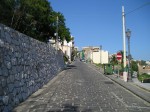
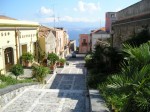
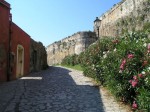
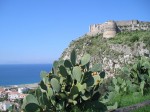
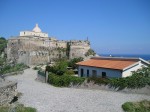

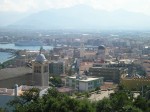
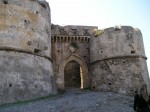
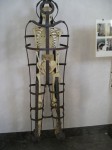
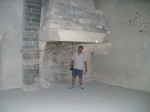
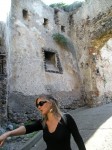
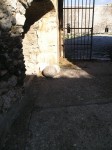
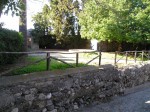
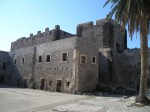
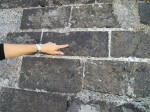
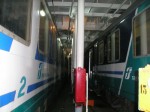
HAPPY BIRTHDAY! I suppose I’ll leave you a message on Facebook as well. That castle sounds amazing and trains being boated across the sea seems pretty hilarious/ridiculous.
~Steve
Happy Birthday!